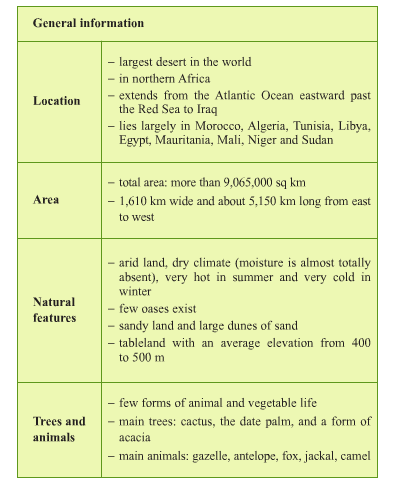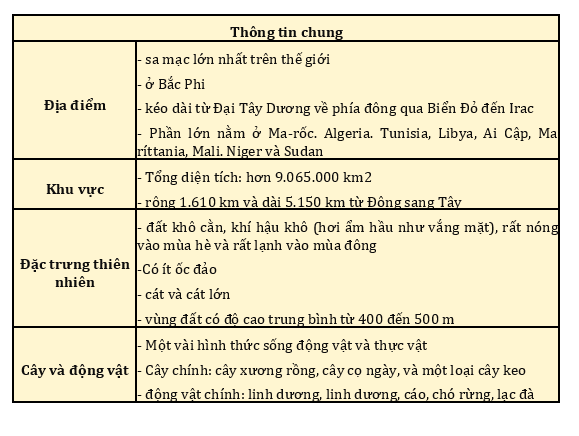Unit 9 lớp 12: Deserts-Writing
Bài học Unit 9 Lớp 12 Deserts phần Writing giúp các em có thêm được nhiều kiến thức về chủ đề chính xuyên suốt trong bài học này, đó là tìm hiểu về hoang mạc Sahara. Qua việc các em tìm hiểu thông tin cho trước, mình có thể hình thành ý tưởng và hoàn thành bài văn hoàn chỉnh về nó.
Mục lục nội dung

1. Writing Unit 9 lớp 12
THE SAHARA DESERT
Study the information in the table below and write a composition about the Sahara Desert (Nghiên cứu thông tin ở bản dưới đây và viết nội bài luận về sa mạc Sahara)
Tạm dịch
Guide to answer
The Sahara Desert, the largest desert in the world, is located in the northern Africa and occupied approximately 10 percent of the African continent
From the Atlantic Ocean in the west, the Sahara Desert stretches across Africa to the Red Sea and down to the highlands of Ethiopia, covering an area of 9,100 000 square kilometres, 1,610 kilometres wide and about 5,150 kilometres long from east to west.
The Sahara is one of the hottest region in the world, with arid land, and dry climate. In the hottest months, temperatures can rise over 50°c, and temperatures can fall below freezing point in winter. A single daily variation is from -0,5° c to 37,5°c. The Sahara is also extreme windy, which creates dust devils which can make the temperatures even hotter.
The surface of the desert ranges from large areas of sand dunes to stone plateaus, gravel plains, dry valleys and salt flats. People, can find some tablelands with an average elevation from 400 to 500 metres. Very few forms of animal and vegetable life can be seen in the Sahara. Plants and animals of the Sahara are more threatened by desiccation than the fauna and flora in other parts. The main trees can be seen are cactus, date palm and a form of Acacia.
In the vast area of sand and wind, people can find some species of mammals such as desert antelopes, gazelle, fox and jackal. Besides, there are some species of birds and reptiles.
The Sahara Desert is not well-protected. Unless people take appropriate measures to preserve, the flora and fauna of the Sahara is critically threatened with extinction.
Tạm dịch
Sa mạc Sahara, sa mạc lớn nhất trên thế giới, nằm ở phía bắc châu Phi và chiếm khoảng 10% lục địa châu Phi Từ Đại Tây Dương ở phía tây, sa mạc Sahara trải dài qua châu Phi đến Biển Đỏ và xuống vùng cao nguyên của Ethiopia, có diện tích 9.100.000 km2, rộng 1.610 kilômét và khoảng 5.150 cây số dài từ đông sang tây.
Sahara là một trong những vùng nóng nhất trên thế giới, với đất khô cằn, và khí hậu khô. Trong những tháng nóng nhất, nhiệt độ có thể tăng trên 50 ° C và nhiệt độ có thể giảm xuống dưới điểm đông vào mùa đông. Một biến thể duy nhất hàng ngày từ -0,5 ° c đến 37,5 ° c. Sahara cũng cực kỳ lộng gió, tạo ra quỷ bụi khiến nhiệt độ thậm chí còn nóng hơn.
Bề mặt của sa mạc bao gồm từ các khu vực rộng lớn của cồn cát đến cao nguyên đá, đồng bằng sỏi, thung lũng khô và căn hộ muối. Con người, có thể tìm thấy một số lá cờ có độ cao trung bình từ 400 đến 500 mét. Rất ít hình thức cuộc sống động vật và thực vật có thể được nhìn thấy ở Sahara. Cây cối và động vật của Sahara bị đe dọa bởi sự khô hạn hơn các động vật và thực vật ở các bộ phận khác. Cây chính có thể được nhìn thấy là cây xương rồng, ngày cọ và một dạng Keo.
Trong khu vực rộng lớn của cát và gió, người ta có thể tìm thấy một số loài động vật có vú như linh dương sa mạc, linh dương, cáo và chó rừng. Ngoài ra còn có một số loài chim và bò sát.
Sa mạc Sahara không được bảo vệ tốt. Trừ khi mọi người có biện pháp thích hợp để bảo vệ, hệ thực vật và động vật ở Sahara đang bị đe dọa nghiêm trọng bởi sự tuyệt chủng.
2. Practice
Choose the best sentence that can be made from the words given (Chọn câu đúng nhất từ các từ cho trước)
1. The Arabian Desert/ third-largest in the world/ cover/ nearly 1 million square mile of the Arabian Peninsula.
a. The Arabian Desert, is third-largest in the world, covers nearly 1 million square mile of the Arabian Peninsula.
b. The Arabian Desert, that is third-largest in the world, covers nearly 1 million square mile of the Arabian Peninsula.
c. The Arabian Desert, third-largest in the world, covers nearly 1 million square mile of the Arabian Peninsula.'
d. The Arabian Desert, third-largest in the world, therefore, covers nearly 1 million square mile of the Arabian Peninsula.
2. It/ the sandiest/ all deserts/ no river/ flow through/ originate from it.
a. It is the sandiest of all deserts, with no river flows through and originates from it.
b. It is the sandiest of all deserts. No river flows through or originates from it.
c. It is the sandiest of all deserts, but no river flows through or originates from it.
d. It is the sandiest of all deserts. Therefore, no river flows through or originates from it.
3. Arabia's rainfall/ average only 2-5 inches a year/ two- year droughts/ not uncommon.
a. Arabia's rainfall averages only 2-5 inches a year, and two-year droughts are not uncommon.
b. As Arabia's rainfall averages only 2-5 inches a year, and two year droughts are not uncommon.
c. Arabia's rainfall averages only 2-5 inches a year, which makes two year droughts are not uncommon.
d. Arabia's rainfall averages only 2-5 inches a year, and however two year droughts are not uncommon.
4. The desert today/ be characterized/ 700 - foot - high dunes/ giant sand mountains.
a. The desert today is characterized with 700 - foot - high dunes but giant sand mountains.
b. The desert today is characterized by 700 - foot - high dunes and giant sand mountains.
c. The desert today is characterized by 700 - foot - high dunes and however giant sand mountains.
d. The desert today which is characterized by 700 - foot - high dunes and giant sand mountains.
5. The first white man/ traverse/ this desert/ H. St. John Philby/ in the 1930s.
a. The first white man traversed this desert was H. St. John Philby, in the 1930s.
b. The first white man traversed this desert and was H. St. John Philby, in the 1930s.
c. The first white man to traverse this desert he was H. St. John Philby, in the 1930s.
d. The first white man to traverse this desert was H. St. John Philby, in the 1930s.
3. Conclusion
Qua bài học này các em cần lưu ý một số từ vựng sau
- moisture ['mɔist∫ə] (n): hơi ẩm,nước ẩm đọng lại
- prey (n): con mồi, (v): săn mồi
- jerboa [dʒə:'bouə] (n): chuột nhảy
- seed (n): hạt giống
- infrequent [in'fri:kwənt] (adj): ít xảy ra
- livestock ['laivstɔk] (n): vật nuôi, thú nuôi
Tham khảo thêm
- doc Unit 9 lớp 12: Deserts-Reading
- doc Unit 9 lớp 12: Deserts-Speaking
- doc Unit 9 lớp 12: Deserts-Listening
- doc Unit 9 lớp 12: Deserts-Language Focus





